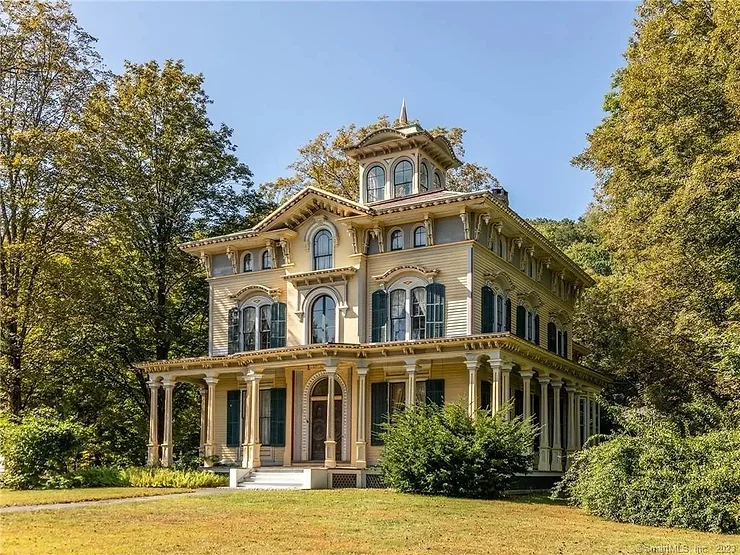MAJOR PRICE REDUCTION The Philip Chapin House – built in 1867 by prominent New Hartford family, this grand Victorian is one of the finest examples of Northern Italian Renaissance style architecture in Connecticut. Careful stewardship has resulted in an incredibly rare preservation, with astounding original details on both the exterior and interior. Grand foyer, sweeping staircase, striking arched doorways, twelve-foot ceilings, electrified, original gas lamps. Grand entertaining spaces – notably a large sun-filled parlor and music room, each with original floor to ceiling windows, carved stone fireplace surrounds, gold leafed valances and mirrors, exquisite mouldings. Entertain a la “The Gilded Age” or settle into a cozy study with the original built-in walnut desk and bookcase – home boasts both grandeur and comfortable living. Period kitchen highlights historic details. Upper level with lofty ten-foot ceilings. Four main bedrooms feature corner marble sinks, one with original sterling silver faucet. Two full baths. Rear upper level with back stairs to kitchen, two additional rooms for guests or offices, and a laundry room. Well sited on two acres overlooking historic town green. Campus-like grounds, in-ground pool, blue stone patio. Sweeping, wraparound veranda, carriage house with garage bay. Impressive belvedere that sits atop the home is the epitome of Victorian architecture. Listed on the National Register of Historic Places in 1977. THIS IS YOUR CHANCE Homes in the New Hartford Historic District have the potential for alternative use with application for special exception. COULD BE FABULOUS B&B OR EVENT SPACE.
Listed by:
Jessica Travelstead,
W. Raveis Lifestyles Realty,
Travis Lipinski,
W. Raveis Lifestyles Realty
55 Church St, New Hartford, CT 06057
5 beds, 3 baths, 4,681sqft.
Photos:


































Embracing Elegance: A Stunning Example of Northern Italian Renaissance Style Architecture
In the world of architectural splendor, few styles capture the grandeur and sophistication of the Northern Italian Renaissance like its finest examples. Rooted in a rich history of artistic and cultural rebirth, Northern Italian Renaissance architecture stands as a testament to the ingenuity and aesthetic sensibilities of its era. Among the most exquisite examples of this architectural style is a residence that epitomizes the elegance and intricate craftsmanship of the period.
A Glimpse into Northern Italian Renaissance Architecture
The Northern Italian Renaissance, flourishing from the late 15th to the early 17th centuries, is characterized by its distinctive blend of classical antiquity and innovative design elements. This style emerged in cities such as Venice, Milan, and Florence, reflecting the region’s unique artistic and cultural advancements. The architecture of this period is known for its symmetry, proportion, and use of classical elements like columns, pilasters, and entablatures, often combined with a rich array of decorative details.
Architectural Features
Classical Proportions and Symmetry:
Northern Italian Renaissance architecture is renowned for its emphasis on proportion and symmetry. Buildings often feature balanced facades with harmonious spacing of windows, doors, and decorative elements. The use of classical orders, such as Doric, Ionic, and Corinthian columns, provides a sense of order and grandeur.
Ornate Facades and Decorative Details:
One of the hallmarks of this style is the elaborate decoration on building facades. Carved stonework, intricate friezes, and decorative reliefs often depict mythological, historical, or allegorical themes. The use of classical motifs, such as garlands, masks, and medallions, adds a layer of artistic richness to the architecture.
Use of Arches and Domes:
Arches and domes are prominent features in Northern Italian Renaissance architecture. Rounded arches, often supported by robust columns, are used to create grand entrances and windows. Domes, which can be seen in religious and civic buildings, contribute to the sense of monumental scale and grandeur.
Elegant Interiors:
The interiors of Renaissance buildings are equally impressive, featuring grand halls, vaulted ceilings, and richly decorated rooms. Frescoes, intricate plasterwork, and luxurious materials such as marble and wood are commonly used to enhance the interior spaces.
A Prime Example: The Villa Farnese
One of the most celebrated examples of Northern Italian Renaissance architecture is the Villa Farnese in Caprarola, Italy. Designed by the architect Antonio da Sangallo the Younger, this villa exemplifies the grandeur and elegance of the Renaissance period.
Villa Farnese Highlights:
Symmetrical Design: The villa’s layout is a prime example of Renaissance symmetry and balance. Its polygonal plan and centralized courtyard reflect the architectural principles of the time.
Ornate Facades: The facades are adorned with intricate carvings and decorative motifs, showcasing the skill of Renaissance artisans. The use of classical elements such as columns and pilasters adds to the villa’s stately appearance.
Grand Interiors: The interior of the Villa Farnese features richly decorated rooms with frescoes, stucco work, and luxurious materials. The loggia, or open gallery, offers stunning views of the surrounding landscape, blending indoor and outdoor spaces.
Conclusion
The Northern Italian Renaissance style represents a pinnacle of architectural achievement, characterized by its emphasis on classical design principles, intricate ornamentation, and harmonious proportions. A residence or building that exemplifies this style offers a window into the artistic and cultural renaissance of the period, combining timeless elegance with innovative design. Whether through grand villas like the Villa Farnese or other masterpieces of the era, Northern Italian Renaissance architecture continues to captivate and inspire with its enduring beauty and sophistication.
CREDIT : HistoricalHomesofAmerica
